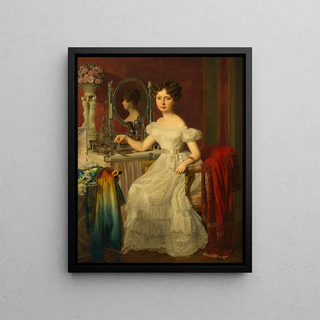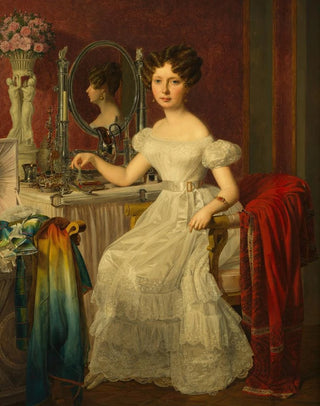Art print | L'actress Elise Höfer - Ferdinand Georg Waldmüller


View from behind

Frame (optional)
The art print "The Actress Elise Höfer" by Ferdinand Georg Waldmüller is an iconic piece from the 19th century, embodying both the beauty and complexity of portraiture. This painting, which captures the grace of an actress from that era, evokes an atmosphere of romanticism and intimacy. Waldmüller, a master of realism, succeeds in transcending mere portraiture to offer a true study of character. Through his brushwork, he invites us to discover not only the face of Elise Höfer but also the soul of a woman in full light, revealing the nuances of her expression and gaze. This work, rich in detail and emotion, is a living testament to the art of representation in the 19th century.
Style and uniqueness of the work
Waldmüller's style is distinguished by his ability to blend meticulous realism with romantic sensitivity. In "The Actress Elise Höfer," each brushstroke seems charged with intention, and every shadow and light is carefully placed to emphasize the depth of the actress's face. The background, often blurred and indistinct, highlights the main subject, creating a contrast that immediately draws the eye. The color palette, soft and harmonious, evokes an atmosphere of serenity and contemplation. This painting is not just a simple portrait; it tells a story, that of a woman who, through her presence, captivates the viewer. Waldmüller manages to bring his model to life, transforming a frozen moment into an emotional experience.
The artist and his influence
Ferdinand Georg Waldmüller, born in 1793, is a significant figure in 19th-century Austrian art. His innovative approach to portraiture and his ability to capture the essence of his subjects made him a respected and influential artist. Waldmüller was a pioneer of realism, breaking away from the academic conventions of his time to explore more personal and intimate themes. His work has inspired many artists, both in Europe and beyond, contributing to the evolution of modern art. By emphasizing individuality and the expression of emotions,

Matte finish

View from behind

Frame (optional)
The art print "The Actress Elise Höfer" by Ferdinand Georg Waldmüller is an iconic piece from the 19th century, embodying both the beauty and complexity of portraiture. This painting, which captures the grace of an actress from that era, evokes an atmosphere of romanticism and intimacy. Waldmüller, a master of realism, succeeds in transcending mere portraiture to offer a true study of character. Through his brushwork, he invites us to discover not only the face of Elise Höfer but also the soul of a woman in full light, revealing the nuances of her expression and gaze. This work, rich in detail and emotion, is a living testament to the art of representation in the 19th century.
Style and uniqueness of the work
Waldmüller's style is distinguished by his ability to blend meticulous realism with romantic sensitivity. In "The Actress Elise Höfer," each brushstroke seems charged with intention, and every shadow and light is carefully placed to emphasize the depth of the actress's face. The background, often blurred and indistinct, highlights the main subject, creating a contrast that immediately draws the eye. The color palette, soft and harmonious, evokes an atmosphere of serenity and contemplation. This painting is not just a simple portrait; it tells a story, that of a woman who, through her presence, captivates the viewer. Waldmüller manages to bring his model to life, transforming a frozen moment into an emotional experience.
The artist and his influence
Ferdinand Georg Waldmüller, born in 1793, is a significant figure in 19th-century Austrian art. His innovative approach to portraiture and his ability to capture the essence of his subjects made him a respected and influential artist. Waldmüller was a pioneer of realism, breaking away from the academic conventions of his time to explore more personal and intimate themes. His work has inspired many artists, both in Europe and beyond, contributing to the evolution of modern art. By emphasizing individuality and the expression of emotions,






